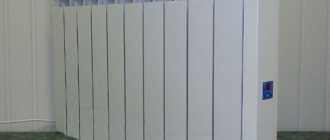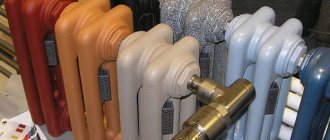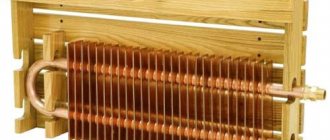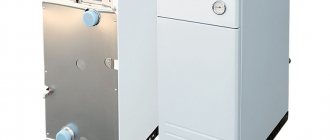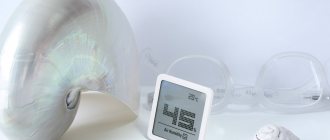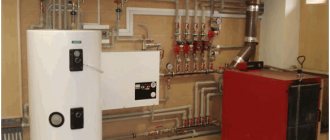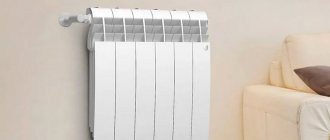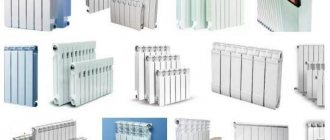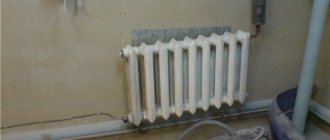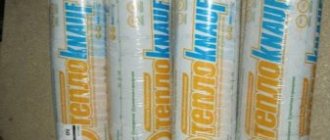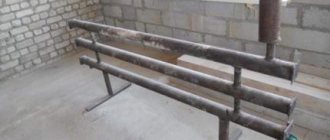The quality and efficiency of the heating system affects the creation of a comfortable environment in the living space. One of the main elements of the heating system is the radiator, which transfers heat from the heated coolant using radiation, convection and thermal conductivity.
They are divided into separate groups depending on the material of manufacture, design, shape, and application.
One of the important details that you need to pay attention to when choosing is the material of manufacture. The modern market offers several options: aluminum, cast iron, steel, bimetallic heating devices.
Aluminum radiators
Aluminum heat exchangers comprehensively heat the room by thermal radiation and convection, which occurs through the movement of heated air from the lower sections of the heater to the upper ones.
Main characteristics:
- Working pressure from 5 to 16 atmospheres;
- Thermal power of one section is 81–212 W;
- The maximum water heating temperature is 110 degrees;
- The pH of the water is 7–8;
- The service life is 10–15 years.
There are two manufacturing methods:
- Liteva.
At increased pressure, separate sections are made of aluminum with the addition of silicon (no more than 12%), which are joined into one heating device. The number of sections varies; additional ones can be attached to one section.
- Extrusion method.
This method is cheaper than casting and involves making the vertical parts of the battery using an extruder, and the collector from silumin (an alloy of aluminum and silicon). The parts are connected; adding or reducing sections is not possible.
Advantages:
- High thermal conductivity
- Light weight, easy installation
- Increased level of heat transfer, which is facilitated by the design features of the heat exchanger.
- Modern design that allows you to fit into any interior.
- Thanks to the reduced volume of coolant in the sections, aluminum units heat up quickly.
- The design of the battery allows the installation of thermostats and thermal valves, which contribute to economical heat consumption by regulating the heating of the coolant to the required temperature.
- Easy to install, installation is possible without the involvement of professionals.
- The outer coating of the battery prevents paint peeling.
- Low cost.
Flaws:
- Sensitive to shocks and other physical influences, as well as pressure surges. These batteries are contraindicated for installation in industrial enterprises due to high pressure in the heating system.
- The need to constantly maintain the pH level of water within acceptable values.
- Contaminated coolant - water with solid particles, chemical impurities - damages the internal protective layer of the walls, causing their destruction, corrosion and blockages, which reduces the service life. Filters need to be installed and cleaned.
- Aluminum reacts with oxygen in water, resulting in the release of hydrogen. This leads to gas formation in the heating system. To prevent rupture, an air release device must be installed, which requires constant maintenance.
- The joints between sections are prone to leakage.
- Aluminum radiators are not compatible with copper pipes , which are often used in modern heating systems. When they interact, oxidation processes occur.
- Weak convection.
Installation and use of plate radiators
Accordion batteries can only operate in heating systems in which forced circulation of coolant occurs. A pump must be used to create high pressure in the circuit. In gravity systems, thin component radiators can be installed.
To install devices of this type, a water heating system is created. It is closed and equipped with an expansion tank. The use of open systems may result in a shorter battery life.
Frequent draining of water is not recommended, since fresh liquid contains a large amount of oxygen. As a result of the impact of this element on structural parts, corrosion of metals occurs, which leads to rapid wear of equipment.
It is also undesirable to install thin batteries in rooms with high humidity, for example, in bathrooms. In this way, the likelihood of corrosion in devices can be reduced.
Pipes for plate radiators can be used either plastic or metal. To protect equipment from the destructive effects of oxygen, an anti-diffusion barrier must be installed.
Steel radiators
Characteristics:
- Heat dissipation – 1200–1800 W;
- Working pressure indicator – from 6 to 15 atmospheres;
- The hot water temperature is 110–120 C.
- Steel thickness is from 1.15 to 1.25 mm.
Advantages:
- Low inertia. The steel heat exchanger heats up very quickly and begins to transfer heat to the room
- Increased heat transfer through thermal radiation and convection
- Long service life thanks to simple design
- Ease of installation
- A light weight
- Low cost
- Attractive appearance, original design. Steel are manufactured in various shapes, allowing them to be placed vertically, horizontally and at an angle
- Compatible with a variety of fastening materials
- High level of energy saving
- Installation of temperature controllers
- Simple design allows for easy maintenance
Flaws:
- Low corrosion resistance. Units made from the thickest steel can withstand a service life of no more than ten years.
- You cannot leave it inside for a long time without water, which is not suitable for central heating.
- Inability to withstand strong water hammer and pressure surges, especially in weld areas.
- If the outer coating was originally applied with flaws, it will begin to peel off over time.
Models of steel radiators differ in the type of connection - it can be side or bottom. The bottom connection is considered universal; it is discreet in the interior, but more expensive.
Depending on the number of panels and convectors, or internal sections, there are several types.
Type 10 has one panel without a convector, 11 has one panel and one convector, 21 has two heating panels and one internal section, and so on, by analogy, types 22, 33 and others are divided. Three-panel heat exchangers are quite heavy, heat up more slowly and require more complex maintenance.
What types of heating radiators are there: types and their advantages
Cast iron radiators
Cast iron radiators are the most “ancient” heating devices that are still used today.
These batteries are characterized by thick walls, are resistant to water hammer and can withstand pressures of up to 30 atmospheres. Cast iron radiators can be used both in an autonomous heating system and in central communications. Cast iron does not corrode, which is why it is so loved in our country. Another advantage is its ability to retain heat for a long time, even after the heating system has been turned off.
The main disadvantage of such products is their heavy weight, which causes some difficulties during the installation process - one person is unlikely to cope with this task.
In addition, cast iron is characterized by low thermal conductivity, for this reason the required effect is achieved at a stable temperature of +70 °C. Thus, for a private home or autonomous heating, this option will be quite expensive, but is perfect for a central heating system in an apartment.
Previously, cast iron radiators had standard dimensions, and to heat the apartment it was necessary to expand the system, and this could spoil the aesthetic appearance of the room. The modern market presents types of heating radiators made of cast iron from domestic and foreign manufacturing companies. Thus, you can now choose small batteries that will suit any interior. Previously, cast iron batteries were attached to the wall using brackets. Now you can choose products with floor installation that differ in aesthetic appearance.
Modern types of cast iron heating radiators do not require additional processing or painting. These products are ready for installation, they are also easy to maintain - practically no dust accumulates on them, since the batteries have a smooth surface.
Due to the variety of shades and styles, modern cast iron radiators not only fit well into any design style, but can even serve as separate decorative elements.
The advantages of cast iron radiators are presented:
- corrosion resistance;
- stylish appearance;
- unpretentiousness to the cleanliness of the medium;
- ability to retain heat for a long time;
- affordable cost;
- ability to function in both central and autonomous heating systems.
Disadvantages of cast iron radiators:
- heavy weight;
- complexity of installation;
- prolonged heating to the required temperature.
Thus, cast iron radiators are the best option for an apartment with a central heating system. Their service life is up to 20 years.
Steel radiators
What types of radiators are suitable for heating a home? To supply heat to private houses and administrative buildings, as a rule, steel heating radiators are used. There are the following types of designs for these heating devices - tubular, solid rectangular or sets of panels consisting of separate sections. If the question is what type of heating radiators to choose for an autonomous heating system at home, then steel radiators are popular because of their affordable cost, beautiful appearance, good heat transfer, corrosion resistance and low inertia.
Steel radiators are not resistant to water hammer and high pressure (25 atm), so it is not advisable to use them as heating devices in an apartment. Also, this type of heating radiators is sensitive to oxygen, which is present in large quantities in the centralized heating network. Heat transfer occurs through the walls and grille, which is located in the upper part of the device. The optimal pressure level for the operation of steel radiators is 6–16 atm, depending on the design of the battery and the thickness of the material. The coolant temperature for this type of heating system radiators is +110 °C.
The advantages of steel radiators are:
- Low inertia. Due to the fact that the steel heat exchanger heats up quickly, the room instantly becomes warm.
- Increased heat transfer, which is provided by thermal radiation and convection.
- Long service life due to simple design.
- Ease of installation.
- Light weight.
- Low cost.
- Attractive appearance and original design. These types of heating radiators are made in a variety of shapes, due to which the devices can be placed in a vertical or horizontal position or at an angle.
- Compatible with various materials that are used as fasteners.
- High level of energy saving.
- Installation of temperature regulators.
- A simple design that ensures easy maintenance of the device.
The disadvantages of these types of heating radiators are:
- Low corrosion resistance. Thus, devices made of a thick layer of steel will last you no more than 10 years.
- It is impossible to leave this type of heating radiator without water for a long time, which means that steel batteries are not suitable for centralized heating.
- Instability to strong water hammer and pressure surges, especially in places of welds.
- There is a risk of peeling if the outer coating of the radiator was applied with defects.
Copper radiators
The advantageous advantage of copper radiators over other types of heating radiators is that they are made from a seamless copper pipe without any other materials. A large diameter pipe, within 28 mm, is complemented by elements such as copper ribs and a decorative wooden casing. The efficient and fast process of heating a room occurs due to the thermal conductivity properties of copper, which are several times higher than those of any other material.
Due to their low inertia, copper types of radiators quickly heat the room and allow the use of thermostats. Such heating devices contain a small amount of water, due to which only three minutes are enough to warm them up. The small volume of water in copper batteries is an important property of these devices for an autonomous heating system, since it does not require heating and driving large masses of coolant through the pipeline, unlike cast iron radiators.
Copper is characterized by ductility, corrosion resistance, high efficiency at low carrier temperatures, and it is not subject to thinning under the influence of an aggressive environment like aluminum. Thus, this type of heating radiator is suitable for use in apartments in multi-storey buildings. It is important to pay attention to the fact that after 90 hours from the start of operation of the device, an oxide layer forms on its inner surface, which subsequently protects the radiator from the negative effects of water with an unfavorable chemical composition.
The advantages of copper radiators are:
- corrosion resistance;
- ability to withstand high pressure in pipes (up to 36 atm);
- high heat transfer.
Among the disadvantages of this type of heating radiator, only its high cost is highlighted.
Read material on the topic: How to change a heating radiator without errors
Aluminum radiators
Aluminum types of radiators have an excellent appearance, however, this type of heating device is far from the best option for use in an apartment with a central heating system. While in residential premises with an autonomous heating system, this type of radiator is very popular. In addition to their stylish appearance, they are distinguished by reliability and long service life - up to 25 years.
This type of heating radiator is made from aluminum, adding silicon alloys, due to which the products become especially durable. As a rule, in industry they use silumin and duralumin to improve the technical qualities of the device. In addition, due to the use of silicon alloys, the cost of the product is slightly reduced.
Aluminum batteries are characterized by a simple design: each radiator section consists of two horizontal channels of large diameter and one vertical channel with a smaller diameter. The vertical channel is equipped with several ribs that “take” energy from the hot water and then “transmit” it into the air space.
This type of heating radiator is designed for a pressure of 15 atm. These batteries are sensitive to air locks and water hammer. To connect the sections, the coupling threaded method is used, due to this the installation of batteries is carried out very quickly.
The tightness of this type of heating radiators is ensured by the casting method. Each section is cast in a separate mold and then combined into an overall structure.
The market offers aluminum batteries of various shapes and sizes, so you can easily choose the appropriate option for your apartment design. The size of this type of heating radiator depends on the area of the room and the heating effect.
Radiators produced using casting technology are distinguished by significant resistance to pressure changes. The operating pressure in them is 16 atm; during testing, the manufacturer exposes the batteries to a pressure of 25 atm, due to which the batteries can withstand sudden changes. The smooth surface of cast panels ensures higher heat transfer.
The extrusion method is also used to produce aluminum radiators. Due to this, the cost of the product is significantly reduced, however, their technical characteristics are somewhat worse than those of cast batteries. These batteries are made from recycled aluminum and are therefore fragile and susceptible to corrosion. Therefore, when you choose a heating radiator, pay attention to both the material and the method used to produce the product. Please note that devices for the production of which extrusion technology was used cannot be expanded. They are standard size.
This type of heating radiator has a fairly small mass, due to which the installation process is significantly simplified, which can be done on your own. Aluminum has high heat dissipation, due to which the batteries heat up in a very short period of time. You can independently control heat consumption and control this system manually, selecting the optimal temperature in the room.
The advantages of aluminum radiators are:
- corrosion resistance;
- stylish appearance;
- light weight (much lighter than cast iron);
- variety of shades;
- high heat transfer;
- variety of sizes;
- the ability to add sections during operation (used only in the case of the casting method).
Disadvantages of aluminum batteries:
- Sensitivity to pressure changes.
- Dependence on water composition. Thus, contaminated water with a high pH level negatively affects the structure and can lead to its failure.
Read material on the topic: Wholesale heating radiators with delivery and quality guarantee
Bimetallic radiators
Among heating radiators, bimetallic types are distinguished, which have an optimal price-quality ratio. They are resistant to excess pressure and are not demanding on the coolant. This explains the popularity of these devices in the construction industry; they are second only to cast iron radiators.
Bimetallic radiators consist of two materials. The outer part is made of aluminum, and the inner layer is made of a high-quality alloy of copper and steel. This combination of materials is designed to solve two problems: improving heat transfer and increasing corrosion resistance. Due to the enamel coating in any color design, the products have an attractive appearance.
The bimetallic type of heating radiator is presented in two modifications:
- An absolutely bimetallic device, characterized by increased strength and resistance to changes in pressure in the network. The service life of these devices is about 25 years, so the high cost of this type of heating radiator is completely justified. This unit has a core made in the form of pipes through which water flows without contact with the body.
- A semi-bimetallic device, which is a structure whose internal channels are reinforced with plates made of other types of metal.
The design of bimetallic heating radiators consists of several sections that are connected by a threaded coupling. Such batteries can be easily expanded by installing additional sections.
This type of heating radiator is an ideal option for apartments with central heating due to its resistance to high pressure (up to 40 atm). They are adapted to sudden changes in operating conditions.
The advantages of bimetallic batteries are:
- ability to heat up quickly and good heat dissipation;
- corrosion resistance;
- stylish appearance;
- large selection of sizes;
- the ability to add sections during use;
- resistance to strong water hammer;
- light weight and simple installation.
Among the disadvantages of this type of heating radiators, only high cost can be highlighted.
These radiators should be purchased exclusively in specialized stores and carefully check the available documentation. Externally, they are very similar to aluminum batteries, but the difference in cost is quite significant.
Bimetallic types of heating radiators are perfect for apartments with any type of heating. At the same time, the high cost is compensated by the long service life of the device.
Read material on the topic: Autonomous heating pipes
Cast iron radiators
They are made of several identical sections cast from cast iron and hermetically connected to each other. When installing such a heater, it is necessary to decide on the number of sections, which depends on the area of the room, the number of windows, the height of the floor, and the corner placement of the apartment.
Characteristics:
- Withstand pressure 18 atmospheres;
- Hot water temperature – 150 C;
- Power 100–150 W;
Advantages:
- Resistant to corrosion. Cast iron is a wear-resistant material; the quality of the coolant does not affect functionality.
- Retains heat for a long time after heating stops.
- Service life 30 years or more.
- Compatible with other materials.
- Increased heat transfer due to the vertical arrangement of the internal fins.
- Heat resistance, strength.
- Due to the internal diameter and volume of the sections, minimal hydraulic resistance is created and blockages do not occur.
Flaws:
- Heavy weight, making it difficult to install and move.
- Slow heating.
- Impossibility of integrating a temperature controller.
- Difficult to care for and paint.
- The outer coating is not durable and may peel and flake. For this reason, it becomes necessary to periodically paint the battery.
- Unpresentable appearance.
- Increased fuel costs due to large internal volume.
- Cast iron heat exchangers have a porous inner surface that collects contaminants, which over time will lead to a deterioration in the thermal conductivity of the battery.
How to determine the required power of a heating device
To make your apartment comfortable in winter, you need to choose the right radiator power. The power of a classic sectional device will depend on the number of sections. When calculating, the following factors must be taken into account:
- the material of the walls in the house is brick or concrete;
- area of rooms;
- the number of windows and their location on the cardinal points;
- number of external walls;
- window quality;
- use of screens for radiators.
Attention: for a standard room with a three-meter ceiling height, having one door and one window, a radiator power of 90 to 125 W will be required per square meter.
The required number of sections will depend on the material the radiator is made of. Power of one section of different types of batteries:
- Cast iron - from 80 to 150 W;
- Aluminum - 190 W;
- Bimetallic – 200 W;
- Steel - from 450 to 5700 W (meaning the power of the entire battery).
Bimetallic radiators
This type includes devices with an aluminum body and steel pipes inside. They are most common when installed in residential areas.
Characteristics:
- Working pressure indicator – from 18 to 40 atmospheres;
- Thermal power – 125–180 W;
- The permissible coolant temperature is from 110 to 130 degrees;
- The warranty period is on average 20 years.
Varieties:
- 100% bimetallic, i.e. the inner core is made of steel, the outer part is made of aluminum. They are stronger.
- 50% bimetallic - only those pipes that reinforce vertical channels are made of steel. They are cheaper in cost than the first type and heat up faster.
Advantages:
- Long service life without the need for maintenance.
- Increased level of heat transfer. This is achieved due to the rapid heating of aluminum panels and the small internal volume of the steel core.
- Strength, reliability, resistance to mechanical stress and pressure surges.
- Resistance to corrosion due to the use of high-strength steel with a special coating.
- Light weight, easy installation.
- Aesthetic appearance that fits into the interior.
Flaws:
- Expensive.
- During the draining of water from the heating system, with simultaneous exposure to air and water, the steel core may be subject to corrosion. In this case, it is better to use bimetallic models with a copper core and aluminum panels.
- Aluminum and steel differ in their thermal expansion rates. Therefore, instability of heat transfer, characteristic noise and crackling inside the device are possible in the first years of operation.
For proper operation of a bimetal heat exchanger, it is recommended to install an air exhaust valve and shut-off valves on the inlet and outlet pipes.
Based on design features, they are divided into the following types:
- Sectional
- Panel
- Tubular
Recommendations for choosing heating batteries
Externally, bimetallic radiators resemble aluminum ones; it is difficult to distinguish them. Without specific knowledge, visual differences are not easy to see. However, when it comes to performance characteristics, bimetallic batteries are much better than aluminum ones. These radiators consist of sections - there can be from several pieces to a couple of dozen. Both aluminum and bimetallic products are assembled almost the same way: the sections are connected to each other using a nipple with different threads, and a gasket is installed between them for sealing. If you had to disassemble the radiator into sections, it is not recommended to use the old gasket when reconnecting - it is better to install a new one to avoid leaks (about
Sectional radiators
Devices consisting of sections of the same type connected together, inside each of which there are from two to four channels through which the coolant moves.
The housing with sections is assembled to the required thermal power, length, and shape. They are made from various materials - steel, aluminum, cast iron, bimetals.
Advantages:
- The ability to install additional sections or remove unnecessary ones depending on the required length of the heat exchanger and the area of the heated room.
- Increased heat transfer produced by radiation and convection.
- By increasing the number of sections, the power of the radiator increases.
- Low cost.
- Economical.
- Installation of temperature regulators.
- Various center distances allow the heater to be installed anywhere.
Flaws:
- The joints between sections are susceptible to water leaks, and with sharply increasing pressure they can separate.
- Difficulties in maintenance associated with removing contaminants in the space between sections.
- The inner surface of the sections has unevenness, which creates blockages.
Imperfections
It is worth noting that cast iron radiators are not without their disadvantages, in particular the following:
- After a long period of use, rust accumulates inside the batteries;
- Due to the small heat-transfer surface and low thermal conductivity of cast iron, heating the room with such radiators occurs quite slowly. Thus, about 80% of the heat is given off to the room in the form of radiation and only about 20% is transferred to the air by convection. Consequently, high-quality heating of the room can be ensured only by installing at least 10 teeth.
- Since cast iron batteries are very heavy, fairly thick pipes will be required for their installation. For the same reason, problems may also arise when mounted on walls.
- Due to the low rate of room heating with cast iron radiators, it would be quite advisable to install control devices at each facility.
- In the presence of automatic heating systems, installing cast iron radiators is very problematic. In addition, they do not save fuel.
- Slow heating of the water inside the cast iron radiator and a much lower return flow temperature than in other devices.
Panel radiators
They consist of two metal panels treated with anti-corrosion protection, fastened together by welding. Inside the panels, coolant circulates through vertical channels, and ribs are attached to the back side to increase the area of the heated surface in a U shape.
Panel heat exchangers are divided into one-, two-, and three-row and are made of steel.
Advantages:
- The variety of sizes of panel boards allows you to select for heating in accordance with the area of the room. Depending on the dimensions, power increases or decreases. The large surface area of the shields has increased heat transfer.
- Due to its low inertia, the battery quickly responds to temperature changes.
- A light weight.
- Thanks to the compact design, the battery can be placed in hard-to-reach areas of the room.
- Low cost.
- To heat a panel radiator, several times less water is required than for a sectional one.
- Aesthetic appearance.
- Ease of installation due to integral design.
Flaws:
- Cannot be used in high pressure systems.
- They need clean coolant without chemical impurities and dirt.
- It is impossible to increase or decrease the dimensions for heating as is the case with sectional ones.
- If painting with a protective material is of poor quality, corrosion may occur.
- Sensitivity to water hammer.
Types of heating radiators depending on design
Depending on the design features, there are several subtypes of radiators:
- Sectional heating radiators - consist of several sections, which means you have the opportunity to assemble a battery of the required size and power. The dimensions and shapes of the sections also vary.
- Tubular radiators are a solid metal structure consisting of an upper and lower horizontal collector, as well as vertical tubes welded to it. These heating radiators in the form of tubes are designed for central heating.
- Panel batteries are made of both steel and concrete. Concrete radiators are built into walls and transfer heat only through radiation.
- Plate batteries are characterized by convective heat transfer. This type of heating radiator consists of a core and ribs mounted on it made of thin plates made of metal.
Corner types of heating radiators can have any design. But they are installed only in the corners of rooms.
Read the material on the topic: Sectional radiators – choosing the best!
Tubular radiators
They consist of vertical tubes from 1 to 6, connected by a lower and upper manifold. Thanks to its simple design, unhindered and efficient coolant circulation is ensured.
The level of heat transfer depends on the thickness of the tubes and the dimensions of the unit itself, which vary from 30 cm to 3 m. The operating pressure withstandable by tubular models is up to 20 atmospheres. Made from steel.
The main advantage is resistance to pressure changes. The rounded edges and shape of the tubes do not allow dust and other contaminants to accumulate on their surface. The appearance is stylish and modern, the variety of shapes allows you to create a designer model for any interior. Strong welded joints prevent water leakage.
Disadvantages: susceptibility to corrosion and cost.
Thanks to convection, such radiators thoroughly warm the air in the room.
When creating comfortable living conditions, attention is paid to details that should harmoniously fit into the design of a residential or public space. Often, when implementing a design project, you need to organically fit every element into it.
The heating device also has a variety of shapes that can create the integrity of the interior. These include vertical, flat, mirror, floor, and baseboard devices made of various materials.
Working and testing pressure
When it comes to the technical characteristics of radiators, pressure indicators are always listed among the first. The usual operating pressure of the coolant is 6-9 atmospheres. Any radiators can cope with this pressure; for cast iron batteries, the standard load is considered to be just 9 atmospheres.
There is also the concept of “pressure testing” - this is the maximum pressure in the system that can occur during its initial startup. For the MS-140 model, this is 15 atmospheres.
Various design solutions for cast iron radiators
According to the regulations, when starting the heating system, it is imperative to check the possibility of smooth starting of centrifugal pumps. In a good way, all pumps should be equipped with automatic equipment that ensures this smooth start. Well, in fact...
In fact, most homes either do not have one or are in poor condition. But even in such a case, the instructions provide a corresponding point: the initial start-up must be carried out with the valve closed, which can be opened (smoothly!) only after the pressure in the line has been equalized. Considering who starts the heating in our homes and how, it is not difficult to imagine the percentage of compliance with these instructions.
If the regulations are violated, the same water hammer occurs, in which an instantaneous pressure surge causes the permissible value to be exceeded, and one of the radiators along the flow of the coolant cannot withstand the load.
The further course of events is clear - its service life is not as long as we would like. Date: September 25, 2022
Vertical radiators
Units with vertical placement were created for those cases where indoor installation is not possible. This depends both on the interior design and on the dimensions or non-standard shape of the living space.
The vertical heat exchanger can be made part of the interior and not hidden behind decorative elements. The main difference is the dimensions, where the length exceeds the width, and vertical placement on the wall. A device of this type is indispensable in a room with panoramic windows.
Vertical radiators can be of various designs - panel, tubular, sectional, and made of various materials - cast iron, steel, aluminum. According to the method of connection to the heating system, there are side, bottom and diagonal.
Advantages:
- Large assortment of shapes and sizes, colors.
- Compactness, which is achieved by reducing the length of the battery along the wall.
- Decorativeness is also expressed in the invisibility of all its fastening and connecting elements.
- Ease of installation, which is achieved due to its low weight and integrity of its structure.
- Large area for increased heat transfer.
- Heating speed.
- Heating does not require a large amount of water, which helps save money.
- Easy to care for.
Flaws:
- Expensive
- The thermal performance of the heater may decrease due to the fact that the air above will always be warmer than the air below. Accordingly, the upper part will give off less heat than the lower part.
- Uneven distribution of heat over the entire area of the room due to the fact that radiated heat accumulates in the upper part of the room.
- It is recommended to install a battery with a reducer to normalize internal pressure.
In other cases, the disadvantages and advantages correspond to those that are characteristic of each type of conventional battery - sectional, tubular, panel.
Factors influencing work efficiency:
- One- or two-pipe connection in the system. The first is less economical in water consumption, but is easy to install and does not require unnecessary costs.
- Type of water supply to the system – top, bottom, side.
- Method of connection to the heating system. Diagonal connection is considered universal.
The effectiveness of heat transfer depends on the correct connection to the heating system. Before installation, it is important to insulate part of the wall to reduce heat loss.
Stand-alone battery models
We figured out what kind of heating batteries there are for standard heating systems. However, it is worth noting the autonomous models of radiators, which are not dependent on the heating system and can be used as an addition. Oil radiators - they are also called oil-filled. This is an excellent solution if you need to heat a small room up to 30 sq.m. Such wall-mounted oil heating radiators operate from the electrical network. They are completely independent from the heating system. They are also mobile - this makes it easy to carry devices.
Oil radiators
Another option is quartz heating batteries. Such devices are a monolithic slab, which is made of a special solution on quartz sand. The heating component is made of an alloy of spirit metals - chromium and nickel, it is completely separated from the environment. The device also operates from the network.
Calculation of heating radiators
Quartz heating batteries
A relatively new solution is baseboard heating radiators. These are comfortable devices that operate from low-temperature sources. Such radiators create a thermal curtain, while maintaining the temperature regime around the perimeter of all rooms.
Baseboard heating radiators
Flat radiators
For compact placement and freeing up space, flat models are used.
Characteristics:
- Smooth front panel that does not allow dust to accumulate on it.
- Dimensions – from 30 cm to 3 m.
- A small amount of water is consumed, which makes it easy to regulate using thermostats.
- Bottom and side connection.
- Used as a decorative element, strict shapes or bright colors.
The operation is similar to panel and sectional: a coolant circulates between two metal sheets; if a heating element is installed, an electric flat version is obtained.
Working pressure is up to ten atmospheres, maximum water heating is 110 C. There are single-panel, double-panel and three-panel heaters.
The main advantage is its compact size and fast heating. In addition, they are easy to care for and have an attractive and stylish appearance. The decoration of flat heat exchangers allows them to fit into any room design, and the mirror surface will replace the mirror. Small installation depth and good thermal radiation indicator.
The disadvantages include the impossibility of installation in wet areas to avoid corrosion, as well as the high cost.
Flat and vertical should be equipped with air release devices, since this arrangement causes a difference in internal pressure.
Infrared heated floors.
Read in detail how to install it in this article. I recommend placing an additional layer of aluminum foil underneath it on a wooden base.
And be sure to always follow the rules for electrical installation on combustible substrates.
- Video 24. Installation and connection of heating.
- Connection and installation of heated floors.
- Installation of heated floors.
- How to calculate a heated floor
Floor radiators
A radiator identical to conventional wall-mounted heat exchangers, but installed on a horizontal surface. It consists of a heat exchanger with a coolant circulating in it, surrounded by plates of aluminum or steel and closed on the outside with a metal sheathing or protective casing.
Equipped with a valve to remove air and connect to pipes of any diameter. The only difference from the wall-mounted options is that the floor radiator is attached to the floor or stands independently on it.
Characteristics:
- Working pressure indicators up to 15 atmospheres;
- The heating temperature of the outer casing is up to 60 degrees;
- Coolant temperature – 110 C;
- Dimensions are up to 2 m in length and 1 m in height on average.
They are made of cast iron, aluminum, steel, bimetals. Many of the models can be transformed from wall-mounted to floor-mounted and vice versa using brackets.
Advantages:
- Fire-proof and injury-proof.
- Uniform heating of the room.
- A variety of shapes and sizes to suit the interior style and at the request of the buyer.
- The use of copper in the heat exchanger improves anti-corrosion qualities and increases service life.
- Built-in electronic and automated control.
- Economical.
- Installation is possible anywhere in the room where a hot water supply pipe is supplied.
- Providing natural convection.
- Built-in additional functions heat and purify the surrounding air.
- A floor-mounted heat exchanger is a convenient option in rooms where it is not possible to install wall-mounted ones due to weight, or where panoramic windows are installed.
- Compact sizes.
- Increased heat transfer.
- Resistance to mechanical stress.
Flaws:
- There may be problems with installation, since installing a floor radiator involves connecting pipes hidden under the floor.
- The cost with copper pipes and aluminum plates is quite high. Cast iron models are cheaper, but have lower thermal conductivity. Steel floor models have low heat transfer.
How do accordion batteries work?
Modern radiators still resemble traditional Soviet batteries in their structure. They have changed in appearance, but have retained the same simple and reliable design that was used for older generation devices. The accordion battery received the following details:
- A curved pipe in the shape of the letter U, which has a pair of ball valves at the ends;
- Plates placed on a pipe. Often all parts are made of the same material, but there may also be combined devices.
- Protective cover. It is a kind of box with an open top and bottom. The internal size of the box allows you to place several pipes in it at once.
Bathroom radiators
A properly installed radiator will ensure a comfortable atmosphere in the bathroom, the absence of dampness, unpleasant odors, and maintaining an optimal level of humidity.
Divided by heating method and shape:
- Water heated by running water
They are connected to the heating system of the house using the conventional wall method. Additionally, it can be equipped with thermostats, with the help of which the required surface temperature is set.
It is recommended to use stainless steel, copper or brass as the outer covering of the water unit.
- Electrical
It functions autonomously and has a built-in heating element powered by mains power. Ease of installation. It is not able to heat the entire area of the bathroom, so it is advisable to use it in conjunction with other heaters, for example, with a heated floor system. In addition, this type is more expensive to maintain than a water type.
- Combined: water and electric.
Capable of operating from the heating system and from the network. The downside is the cost. There are simple forms and designer ones.
Depending on the material there are:
- Cast iron.
Pros: increased heat transfer, cheap price, good service life.
Cons: unattractive appearance. If there is no protective polymer layer, the outer paint coating will peel off and the battery will lose its appearance.
- Steel.
Disadvantages: susceptibility to corrosion, leaks that occur over time, which break through under strong water pressure.
- Aluminum.
Pros: light weight, compact size, attractive appearance.
Disadvantages: not suitable for systems with centralized heating, since they do not tolerate water hammer and coolant contaminated with sand and chemical impurities.
- Bimetallic.
Pros: service life (up to 20 years), good heat transfer performance, resistance to water hammer and pressure changes.
Cons: cost.
- Infrared.
Pros: convenient mounting anywhere in the bathroom, preserving the usable area of the room, ability to regulate temperature, heating objects in the room.
Cons: high cost.
The heating radiator in the bathroom, regardless of type and shape, can be covered with a decorative panel. This way the surface will not be exposed to external influences with a constant amount of emitted heat.
Skirting convectors
Convectors called “Warm baseboard” have two varieties. These are electric and water models. Outwardly, they resemble ordinary plinths in the way they occupy their places or are located next to each other. The heat exchanger is hidden by an aluminum or plastic casing. Skirting convectors are usually small in size. The height of the heater is most often no more than 140 mm and the depth no more than 30 - 50 mm. The convector can be attached to the wall or placed on legs.
Thermal plinth differs from batteries in that it heats the walls and, as it were, forms a thermal curtain. As a result, heat is distributed evenly throughout the entire volume of the room.
Connection to water heating pipes can be done in the same way as with conventional cast iron batteries. The inside of the plinth consists of copper pipes with aluminum ribs or petals, equipped with an air valve.
Technical characteristics of warm water baseboard
| Thermal power | 110 - 700 W/rm (approximately) |
| Operating pressure | 16 bar |
| Maximum heating | 1300 C |
| Coolant | Water or ethylene glycol |
| Life time | 15 – 20 years |
pros
The advantages include the following:
- rapid heating of the room;
- uniform distribution of warm air throughout the entire volume of the room;
- Thermal plinth can be installed on any floor base;
- A small amount of water is required to circulate the coolant.
Minuses
The main complaints of consumers about warm water baseboards come down to its high cost . The high price is explained by the use of expensive materials such as copper.
Warm water baseboard, depending on the model, can be purchased at a price of 15 to 30 thousand rubles. The most famous manufacturers of water-based warm skirting boards are the following companies: Techno Board, Turbo-Tech, STN, Orion and Mr.Tektum.
An electric baseboard differs from a water heater in that instead of water pipes, thermal heating elements (heating elements) are used. Installation of the equipment is quite simple. The plinth is attached to the wall and connected to an outlet.
Technical characteristics of electric warm baseboard
| Power | 140 – 500 W/rm |
| Operating voltage | 230 V |
| Maximum temperature | 400 C |
pros
Electric skirting boards are attractive due to their efficiency. After the final heating of the walls, energy consumption is significantly reduced. Electricity is consumed only to maintain temperature conditions.
Minuses
Electric skirting boards are installed in permanent residences and are completely unsuitable for summer cottages. It can be purchased at an average price of 6 thousand rubles. per linear meter. Well-known manufacturers of thermal skirting boards in Russia are the following companies: Techno Board, Turbo-Tech, Charley, Orion and Mr.Tektum.
Radiator for apartment
In apartment buildings, not every unit can be used effectively for many years.
It is necessary to take into account the features of the central heating system:
- The coolant is contaminated in the form of various chemical impurities that can cause corrosion over time.
- Hard grains of sand and other blockages affect the pipe walls over time, causing them to wear out.
- The water temperature changes, as does the acidity level.
- Pressure surges cause divergence of the weld joints on the walls.
Selection options:
- The operating pressure in the unit specified by the manufacturer exceeds the pressure in the heating system.
- The heating device is resistant to water hammer.
- The inner surface of the heat exchanger walls must have a special protective coating that protects against the chemical effects of the elements on each other, and the thickness of the walls must withstand the physical effects of clogging particles from the inside.
- It is worth choosing the one with the greatest heat transfer.
- Duration of service life.
- Exterior design.
Options suitable for installation in an apartment:
- Bimetallic.
They meet all the necessary parameters for installation and long service in an apartment in a multi-storey building. They withstand water hammer, the maximum operating pressure is up to 50 atmospheres, internal and external treatment with a protective coating protects the surface from corrosion and wear.
Light weight makes installation easy, and the appearance is attractive in any interior. The only negative is that it is expensive.
- Cast iron.
The long service life, thick walls, resistance to corrosion, and chemically passive material of such heat exchangers create conditions for use in an apartment. Cast iron retains heat for a long time compared to other materials. Radiation heating is more effective than convection.
Good heat transfer, affordable price, when draining water from the system, the inner surface does not rust. Disadvantages - cast iron may not withstand too large pressure surges, it is heavy and creates inconvenience during installation.
Not suitable for installation in an apartment:
- Steel.
They cannot withstand the pressure typical of a central heating system, despite good heat transfer and economical use of resources.
- Aluminum.
Aluminum quickly corrodes when combined with water containing chemical impurities and its pH level, and cannot withstand high pressure in the heating system.
Bimetallic and cast iron are suitable. If the height of the house is more than five floors, and non-cast iron batteries were initially installed in the apartment, it is recommended to install bimetallic ones.
Types of heating devices
Accordion radiators are often classified according to the following criteria:
- The material from which pipes and plates are made;
- Number of “threads” in the casing;
- Connection diagram of the device to the coolant;
- Type of fastening of the casing to the support.
The first two types of device separation were described above. The third type of sorting of devices distinguishes the following varieties:
- With side connection. In this situation, the radiator fittings are located on the side of the casing. If the wiring in the room is installed horizontally, then the consumer will need to purchase special fittings. With their help, you can ensure the connection of the pipes of the device and the fittings to which it will be attached. In the case where the distribution pipes are located in a horizontal plane, angles are not used.
Side connection Source stroy-podskazka.ru
- With connection from below. In such products, the fittings are located on the bottom, which simplifies the connection with horizontal pipes, but complicates attachment to a vertically located system.
Connection from below Source fixmaster74.ru
The type of fastening to the supporting surface distinguishes the following devices:
- Mounted – mounted using special brackets;
Mounted radiator Source gipsokarton-blog.ru
- Built-in - their body is located below the floor level, installed directly on the floor slab.
Built-in radiator Source otoplenie-gid.ru
The first option has gained popularity due to its ease of installation and easy access to the structure. For floor products, you need to create a special niche and perform hidden wiring installation.
Selecting a radiator for your heating system
The heating scheme largely determines which radiators are best suited in each specific case. A single-pipe heating scheme involves the supply and removal of coolant to the radiator through one pipe. With such a system, each battery is connected in series, in a chain, to a common riser.
It is used less and less, as it has a number of disadvantages: the complexity of setting up the system, since changes in one radiator affect all the others, the presence of a common riser of a large diameter.
With a two-pipe heating scheme, the radiators are connected in parallel: one pipe supplies the coolant, the second drains it. This system requires much more piping but does not have the disadvantages of a single pipe system. Adjusting one radiator has virtually no effect on the others.
The heating scheme largely determines which radiators are best suited in each specific case (click to enlarge)
Based on the characteristics of communication between the coolant and the atmosphere, heating circuits are divided into open and closed. With an open system, at the highest point there is an expansion tank that communicates directly with atmospheric air. Circulation in such a system is carried out naturally, due to the slope of the pipelines and the difference in pressure of the hot and cold coolant.
The closed system has a special expansion tank with a diaphragm. The coolant does not come into contact with atmospheric air. In such a system there is forced circulation, which is much more reliable and does not require slopes. Most modern systems are closed.
In schemes with an open tank, water can quickly cool down in winter. Therefore, it is customary to select cast iron batteries for them - inertial devices (click to enlarge)
With an open heating system, excess pressure pushes the coolant into the expansion tank, which is directly connected to the atmosphere. This coolant contains a high percentage of oxygen, which causes corrosion.
In a single-pipe heating circuit, all devices are connected in parallel, the coolant flows from one to another and cools. For these schemes, cast iron appliances are also preferred, as they retain the resulting heat for a long time (click)
With a two-pipe system, radiators are connected in parallel, and the coolant has no contact with atmospheric air.
Specifics of central heating
With central heating, the coolant is under high pressure. Circulation may not occur continuously. Therefore, it is advisable to use radiators with high inertial properties.
Capable of storing heat during intensive circulation, preventing the room from overheating. And vice versa, do not cool down so quickly when circulation stops.
Image gallery
Photo from
Cast iron radiators in centralized networks
Batteries with increased thermal inertia
Difficulty in using automatic thermostats
Predominant use of cast iron batteries
The higher the inertia of the radiator, the more even the temperature will be maintained in the room. With central heating, ordinary process water acts as a coolant.
However, due to the extended and complex system, it is sometimes highly polluted and gassed. As a result, the coolant causes increased corrosion. The accompanying sediment will clog the narrow channels of the radiators, significantly reducing the effective heat transfer.
Features of autonomous heating
The basis of an individual heating system is most often gas boilers or similar equipment running on liquid fuel or pellets. Particularly effective with a two-pipe system.
Such a system is closed, the coolant circulation is constant and is carried out using a circulation pump. Boiler equipment turns on automatically, depending on the temperature of the coolant.
When configured correctly, it allows you to achieve very efficient operation. Using low-inertia radiators and a comb system, it actually supplies coolant only to the required heating radiator. This happens due to constant circulation.
A heating system with comb collectors allows you to install any radiator, because... distributes the coolant throughout all devices
In such a radiator, the flow occurs faster, the lower the coolant temperature. The hot coolant will flow directly into the coldest radiator, due to the greatest pressure difference.
Since the automation of heating equipment constantly maintains the set temperature of the coolant: the lower the inertia of the radiator, the more accurately the temperature in the room will be maintained. Characterized by high quality coolant and lack of gas contamination, low pressure.
Individual heating using solid fuel is based on manually loaded boilers. In particular, this leads to significant changes in coolant temperature during the day. To reduce the cost of the entire system, very often, an open-type single-pipe system is used (communicated with atmospheric air).
With a single-pipe gravity flow design, the pressure in the system is minimal, the coolant is contaminated with corrosion products and gassed. It is desirable to use radiators with high inertia and corrosion resistance.
You can read about the design principles of a two-pipe system and options for connecting radiators to it in the article we recommend for your reading.
Individual heating of a summer house or hunting lodge is distinguished by the ability to reduce the temperature of the coolant to negative temperatures. Special antifreezes are used as a coolant; among other advantages, they have anti-corrosion properties.
The system is characterized by low pressure. To quickly warm up all rooms, a reasonable choice would be to use radiators with minimal inertia.
Connection options
Radiator connection options
There are several types of connections, including bottom, diagonal and side. Each of them has its own characteristics, so when choosing, you need to focus on the type of heating system, room area, and other factors. It is best to contact specialists who will install the battery taking into account the rules and standard standards.
Diagonal
This type of connection is suitable for single-pipe systems. This method allows you to distribute hot water as efficiently as possible. When there are more than twelve sections in one radiator, you need to use special nozzles so that the flow passes deep into the heating device. To clarify the exact number of sections, you need to calculate the power using a calculator in order to eliminate possible errors. This scheme allows the heat carrier to pass diagonally through the entire volume and uniformly heat all sections.
Lower
Devices with this connection method are called universal. Their main advantage is complete invisibility and the ability to harmoniously fit the unit into the interior and space of any type. This is possible through the use of corner and straight fittings, which are also called radiator binoculars in the language of plumbers. The complete set of units includes a thermostatic valve, a thermal head and much more. Although they are not more expensive compared to other types of radiators, this is a good option for most modern houses and apartments.
Lateral
With lateral connection, the radiator potential is fully used
Devices with a side connection method are most popular among buyers, and not only because of their low price. Such radiators are switched in several ways; most often, a one-sided side circuit is used, thanks to which the potential of the device is fully used. Lateral diagonal connection is used only for units with a large number of sections; this option has a negative impact on aesthetics, but provides an ideal level of thermal output and heating.
